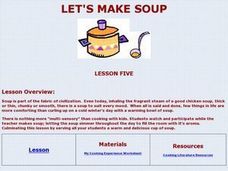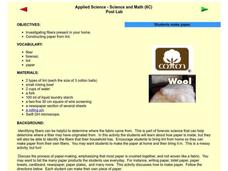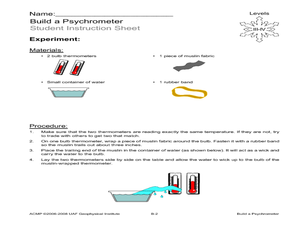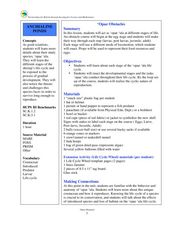Curated OER
Herbert Hoover and the Dust Bowl
Shanty towns made by Dust Bowl migrants were called Hoovervilles for a reason. Examine the policies Herbert Hoover put in place to help victims of the Dust Bowl and Great Depression. You'll find he didn't do much and the result was...
Curated OER
Fast, Fun & Easy Fabric Bowls
Students listen to the teacher who explains the layering of the bowl; demonstrating marking and freehand cutting and fusing. They use satin stitch to practice on scraps. Teacher talks about finishing the edge. Students mimic.
Curated OER
Keep the Wet Out
After reading a short paragraph about certain materials and their ability to repel water, learners answer two questions regarding a variety of materials' ability to repel water. There are six different substances placed in bowls of...
Curated OER
Shoe Shine
Young artists use Paintstik colors on paper, canvas, metal, fabric or another surface to create a work of art to be presented in a gallery. Students research the origins of the "Snakebasket" they are creating. These art lessons produce...
Curated OER
Feast For 10
Young scholars complete a variety of activities related to the book "Feast For 10" by Cathryn Falwell. They read the book and follow the recipe for pumpkin pie from the story. Students then write about their cooking experience,...
Curated OER
Let's Make Soup
Students investigate the fresh produce native to specific parts of the world. In this culinary lesson, students complete a cooking worksheet based on the ingredients used in cultural dishes. Students help create a bowl of soup which...
Curated OER
Toilet Paper
In this reading comprehension worksheet, students read a 4-paragraph article titled "Toilet Paper" and respond to 8 multiple choice questions and 7 short answer questions.
Curated OER
Create a Research Book
Students use the internet to research the production of manuscripts and books. Using this information, they create a research book full of tips to research effectively. They share their new book with the class after organizing the material.
Curated OER
Canvas Dinnerware
Take recycling to a new height. Learners use china or plastic dinnerware from thrift stores to create great works of art. They discuss great works of art, talk about techniques, and design their own piece.
Curated OER
Applied Science - Science and Math Post Lab
Students construct paper. In this applied Science lesson, students create paper using lint. Students investigate the different fibers in their homes.
Curated OER
Activity Plan 3-4: Still Life Artists
Students find that still life's are a great way to jump-start art. In this early childhood art lesson, students examine famous still life paintings, discuss still life art, and create their own still life piece.
Curated OER
Build a Psychrometer
Students understand that a psychrometer is a weather instrument used to detect humidity. In this psychrometer lesson, students build a psychrometer. Students use their psychrometers to measure humidity activity.
Curated OER
The Invisible Energy in Light
Young scholars investigate radiant energy. In this earth science instructional activity, students use solar beads and clear sunscreen to observe radiant solar energy. Young scholars note observations.
Curated OER
African Markets: Out in the Open
Students identify advantages and disadvantages of African open air markets. They discuss the types of items sold there and why the markets are outdoors. They observe a bartering session between the teacher and another adult. Finally,...
Curated OER
Coil Baskets
Young scholars design and create coil baskets using strands of yarn or other fiber.
Curated OER
Industrial Strength Design
Students design, invent, and build a model of something new, useful, or decorative to solve a problem using any combination of materials provided. They also create logos, packaging, etc. related to product sales.
Curated OER
Tie Dye Eggs
Young scholars create "tie-dye" easter eggs in this easy elementary school lesson. Materials needed include paper towels, food coloring, eggs, and rubber gloves. This Easter lesson can be accomplished in 30 minutes with extra time...
Curated OER
Who Has Hair?
Students explore similarities and differences. In this Teaching Tolerance instructional activity, students read literature and participate in activities that features mammals and their hair. Students learn that they share things in...
Curated OER
Opae Obstacles
Students explore the life cycle of shrimp. In this life cycle lesson, students research the different stages of a shrimp's life cycle. Students examine threats to the species in each stage of life.
Curated OER
Preventing Hypothermia
Students identify the causes of hypothermia. In this biology lesson, students investigate the different types of heat transfer and heat loss. They discuss several practical measures to avoid hypothermia.
Curated OER
Markets of Africa
Students identify one advantage and one disadvantage to open air markets in Africa. students create a mural on paper to be hung on the classroom wall. Small groups make a stand of something that would be sold at an open air market.
Curated OER
Building Aqueducts
Students simulate building a Roman aqueduct using an interactive website. In this social studies lesson, students design their own class aqueduct. They construct one inside the science classroom.























